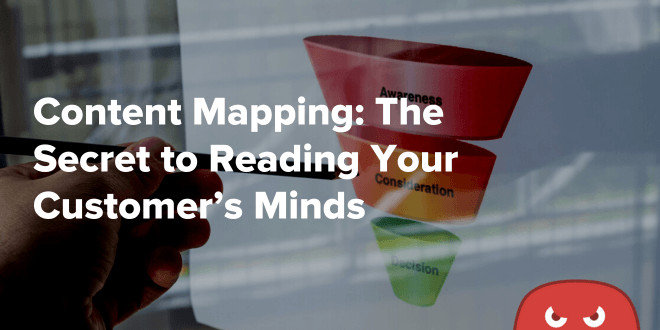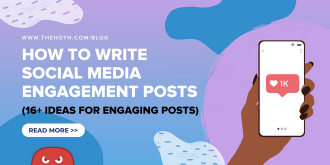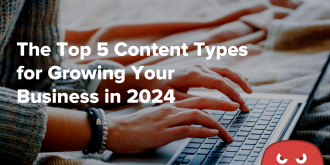Quick Links
When was the last time you viewed a brand-new website and immediately made a purchase without doing any research?
Our guess is never.
That’s because a typical purchasing experience is much more complex than ‘see the product, buy the product.’
Instead, there are levels to this, which is why you need to use content mapping.
In particular, those levels comprise your buyer’s journey and the different stages of your sales funnel – and content mapping is how you present the right c
In particular, there are levels to your buyer’s journey and sales funnel.
For example, the levels of a typical customer’s journey look something like this:
- Research products and services using a search engine like Google (this is the first step for 89% of customers online).
- Compare a few different providers to determine who has the highest quality, most affordable offering.
- Make an ultimate decision and make a purchase.
These correspond directly with the levels of your sales funnel:
- Awareness. The prospect becomes aware of your brand.
- Consideration. They begin researching your products and services.
- Decision. They decide to purchase something from you.
A content map helps you develop the right type of content for each level since each stage has different content needs.
During the awareness stage, prospects are looking for informative and educational content. Once you have their interest, then you move on to content like buyer’s guides, testimonials, and reviews to convince them to buy something.
Stay tuned to learn how you can develop a detailed content map to ensure you always deliver the perfect content at the right time for your audience (making you appear like a mind reader in the process).
What Is Content Mapping?
A content map aligns your brand’s content with a typical customer’s buying journey.
It’s a literal blueprint that visualizes:
- The specific people you’re trying to reach (their interests, desires, pain points, etc.).
- The stage of the sales funnel they’re in (awareness, consideration, decision).
- The kind of content that best resonates with your audience at each stage of their journey (blog posts, videos, infographics, etc).
- The end goal of each piece of content (to educate, generate leads, drive sales, etc.).
Why Bother with Content Mapping?
If you’ve put in the SEO work and your web pages are ranking well, you may not feel the need to bother creating a content map.
After all, if it’s not broken, why fix it?
However, you need to ask yourself a very important question:
Are my search rankings translating into the results I want for my business?
#1 search rankings are great, but if your conversion rates, bounce rates, and dwell times are less than stellar, you’re doing something wrong.
For example, if you’re ranking in the #1 spot for crucial ‘money’ keywords (keywords that drive purchases), but you still have low conversion rates – that’s a telltale sign that your content is failing you.
With the lack of a content map, you may create content that doesn’t fully satisfy your visitor’s search intent (the reason they clicked on the page in the first place).
If a visitor wants to learn more about your brand but gets directed to a hard-sell product page straight off the bat, they may get turned off and click back to the search results.
That’s why content mapping and SEO go hand-in-hand.
A content map maximizes your SEO investment by ensuring you’re delivering the right content to satisfy search intent. This means more conversions, happy visitors, and a stronger brand reputation.
If you’re ready to see your SEO efforts pay off, let’s explore how a content map will transform your customer experience.
How to Create a Content Map
Just as a pirate’s treasure map leads to treasure, your content map leads you to more online revenue.
However, you need to know how to create a quality content map for it to work. Otherwise, it will lead you to a pile of coal instead of a pot of gold.
To create a content map, you need to understand your target audience, which brings us to the first step.
Step #1: Build buyer personas
A buyer persona (also called a customer avatar) is a fictional representative of a member of your target audience. It’s a tool for familiarizing yourself with your target audience by outlining their key characteristics, challenges, and motivations.
Personas help you tailor your content to truly resonate with your audience’s needs, desires, pain points, and interests.
When done correctly, this leads to more engagement and better results from your content strategy.
Let’s work together and create a buyer persona from scratch.
We’ll say that your fictional company is Acme Solutions, a software company specializing in human resources management software.
Demographics
Start with the basics like:
- Name: Overworked Olivia
- Age range: 32 – 45
- Gender (if applicable to your product/service): Female
- Location (general region or even specific cities): Suburban/urban areas
- Job title/Industry: HR hiring manager
- Income level/Budget: Willing to make a modest investment to improve productivity and time management
- Education level: College graduate
- Hobbies: Reading novels, gardening
Pain points
What problems does your ideal customer experience that your product or service can solve? Be as specific as possible.
As an example for Overworked Olivia, many recruiting specialists struggle with finding enough time to review all the resumes they receive for open positions. The average open job position receives hundreds of applications, which provides a daunting amount of work for hiring managers.
If you were selling automated applicant tracking software, you’ve got the perfect solution to her problem, so you should create content based around that pain point.
You could draw her in with a blog piece like ‘How to Easily Manage Hundreds of Applications’ where you show off the automated features of your applicant tracking system.
That’s one simple example of how you can use your audience’s problems and pain points to market your products and services.
Goals
What is your ideal customer hoping to achieve? What are their aspirations, both personally and professionally? How does this align with what you offer?
It could be that your target audience wants to learn a new skill to take their career to the next level, and you sell a product that teaches them that skill.
For Overworked Olivia, she wants to increase productivity and improve her time management. She also wants to gain better visibility into ongoing projects and her current workload.
If you’re able to align your product/service offerings with your audience’s goals, you’ll have an easy time convincing them to make a purchase.
Motivations
What truly drives their decisions? Is it a desire for status, security, convenience, or something else? Understanding motivations helps you craft more persuasive messaging.
This goes a bit deeper than appealing to your audience’s goals.
In particular, someone’s goals are usually driven by their motivations. For instance, if your prospects goal is to advance their career, their motivations are likely to achieve higher status and more security – which you can play to with your content.
Overworked Olivia, as her nickname implies, is overworked and highly stressed. She’s motivated by a desire to free up more of her time and de-stress during the workday.
Online behavior
To really understand your ideal customer, you can also peer inside your customer’s minds by frequenting their favorite online haunts. Think:
➡️ Social media platforms: Your audience’s preferred social media platforms influence your content’s format, tone, and promotion. LinkedIn = professional tone. Instagram/TikTok = informal and fun.
➡️ Websites and blogs: These let you know the type of content your audience regularly consumes online, so take notes.
➡️ Search terms: Specific keywords have the power to uncover your audience’s search intent and the problems they need solutions to.
If you don’t have that kind of data yet, then now is the time to get cracking and start talking to your customers.
For Overworked Olivia, she searches Google for phrases like ‘best HR software for saving time.’ She also reads HR industry blogs and follows relevant social media influencers. She subscribes to an HR newsletter for business tips, and she prefers blog posts and short explainer videos.
Tips for creating buyer personas
Here are some pro tips for creating buyer personas from scratch:
✔️ Don’t rely on guesswork. Conduct interviews with existing customers, analyze your sales data, and use website analytics tools to gather hard insights into your audience’s behavior.
✔️ Interview real customers. Nothing beats direct conversations for understanding motivations and pain points.
✔️ Give your personas names and personalities. This makes them more relatable and will help you remember key details about their motivations/desires/pain points (e.g., “Data-Driven Dave” or “Ambitious Anna”).
✔️ Create 3-5 personas to represent the main segments of your target audience. Instead of treating customer personas as a ‘one-and-done’ deal, you should create multiple personas for each segment of your target audience. If your products and services appeal to multiple demographics, then each one needs a buyer persona.
✔️ Regularly revisit your personas and update them as your business and customer base evolve. Tastes and needs change with time, so your personas will grow stagnant over time. Regularly revisit and update your buyer personas to ensure they stay fresh and relevant.
| Use AI to Build Buyer Personas
AI can also be a massive help with this process. AI programs like ExactBuyer are capable of doing deep dives into vast volumes of customer data, helping you build extremely accurate personas as a result. |
Step #2: Understand your buyer’s journey
Next, it’s time to map out the unique buyer’s journey for each one of your personas.
| What is The Buyer’s Journey?
The buyer’s journey outlines the stages a potential customer goes through before making a purchase. Understanding this process helps you strategically craft content that meets their current needs and nurtures them toward becoming a loyal customer. |
The buyer’s journey consists of three main stages: Awareness, Consideration, and Decision.
For this section, we’ll preview each stage of the buyer’s journey to ‘Overworked Olivia,’ our fictional buyer persona.
She’s an HR professional who has far too many responsibilities and tasks to keep track of during the day. As a result, she’s teetering on burnout and seriously needs a productivity solution to stay organized and take some of the work off her hands.
Your fictional software company has the perfect solution: a comprehensive human capital management (HCM) system that automates repetitive tasks and stores all employee records in one location.
Here’s how you can map out content for Olivia during each stage of her buyer’s journey:
1. Awareness stage
At this stage, the buyer has become aware that they have a problem or a need. They may not have a clear definition of it yet, but they’re beginning to experience some pain points or are seeking to improve something (i.e., their mental health, physical fitness, career advancement, etc).
In the case of Overworked Olivia, she’s feeling overwhelmed and knows she needs a change, but she’s not yet aware of the specific solutions available.
Content focus: Aim for educational and thought-leadership content that helps the prospect understand their problem and positions you as an insightful resource.
Awareness stage content should focus on informing and educating your audience above all else. Avoid hard-sell tactics at this stage, as your primary goal is to position your brand as a helpful resource that will answer their questions and provide solutions to problems.
In addition to providing answers and solutions, awareness stage content can also help define a problem your target audience wasn’t yet aware they had – like that Olivia is feeling burned out due to the lack of HCM software.
So, we want to let Overworked Olivia know that A) she has a problem and B) that we can solve it.
Here are some content ideas:
- Blog post: ‘How Stressed-Out HR Managers Can Boost Productivity’
- Infographic: ‘5 Signs Your Business Needs HCM Software’
- Social media posts: Short posts providing tips on how to automate tasks using HCM features
2. Consideration stage
The buyer has now defined their problem and is actively seeking solutions. They’re busy comparing options, weighing pros and cons, and looking for anything that will help them make the most informed decision.
Olivia is now aware that HCM software will make her life a lot easier. She’s actively researching software tools, and she’s comparing features and pricing.
Content focus: Provide content highlighting your product/service as a solution, demonstrating its benefits, and addressing common objections. Formats like comparison guides, case studies, testimonial videos, and demos are valuable here.
At this stage, your goal is to convince your audience that your brand stands tall above the competition. That means providing plenty of social proof via case studies and testimonials to show off your past successes.
For Olivia, we want to convince her that our HCM software is the no-brainer choice for her specific needs.
Here are some content ideas:
- Case studies: Success stories from HR professionals who used your software
- Webinars: In-depth demonstrations of what your software can do (and comparisons to competitors)
- Product reviews/testimonials: Highlight positive reviews and testimonials from past customers vouching for the quality of your product.
| Advanced Tip: Identify Potential Deal Breakers
Put yourself in the buyer’s shoes at the decision stage. Brainstorm objections they might have such as price, competing features, your brand’s reputation, etc. Address these concerns in your content to demonstrate why your solution is the best choice, even when it’s not the cheapest or most popular (yet). |
3. Decision stage
The buyer has nearly made up their mind and is ready to commit to a particular solution/vendor. They’re likely conducting a few final comparisons of their top options, and it’s up to the strength of your decision stage content to ensure your brand comes out on top.
Overworked Olivia is just about ready to commit to your software, but she has a few lingering doubts. As a result, she’s doing some final searches to compare the price, value, and learning curve of your product compared to her second most-liked option.
Content focus: Content for decision-stage buyers could offer free trials, personalized pricing consultations, testimonials, and any further information that reassures them of their choice. Also, hit potential customers with strong product pages containing your highest converting CTAs (calls to action).
Here are some content ideas for Olivia:
- Free trials or product demos: Give Olivia hands-on experience with your tool to put her mind at ease regarding the learning curve.
- Pricing guides: A pricing guide provides Olivia with different pricing plans that cater to her budget needs.
- Dedicated consultations: A consultation gives Olivia the chance to ask any lingering questions she has about the product.
✨ Bonus: Delight stage
Some models expand the buyer’s journey to include post-purchase stages focused on customer retention and advocacy.
After all, it would be a shame to convert a prospect only to lose their repeat business down the line.
By ‘delighting’ your customers with additional content and support, you’re showing that you value their business – and that you’ll do whatever you can to provide helpful resources.
At this point, Olivia has decided to implement your software. Now, the challenge becomes ensuring she gets maximum value out of your program and becomes a lifelong customer and brand advocate.
Content focus: Onboarding materials, knowledge bases, exclusive content, and community-building initiatives help keep customers engaged and successful, turning them into advocates for your brand.
Here are some delight stage content ideas for Overworked Olivia:
- Onboarding tutorials: Easy-to-follow setup guides and tutorials for using your software.
- Knowledge base articles: Olivia can reference these if she runs into an issue or doesn’t know how to access a certain feature.
- Community forums: If Olivia runs into a particularly perplexing problem, she can ask some of the user experts on your community forums for assistance.
Step #3: Conduct a content audit
Before you start pumping out new content, you’ve got to know what you already have. A content audit helps you identify gaps, repurpose existing assets, and streamline your content strategy. Here’s how to knock one out:
Step 1: Gather your inventory
Create a content master list: Use a spreadsheet or a content management tool to compile a comprehensive list of ALL your existing content. Include:
✅ Blog posts
✅ Website pages (landing pages, product pages, etc.)
✅ Videos (webinars, explainer videos, etc.)
✅ Social media posts (if they contain substantial content)
✅ Ebooks, whitepapers, reports
✅ Slide decks
✅ Any other content formats you use
Step 2: Analyze and categorize
For each content piece, record the following:
➡️ Topic: What is the main subject matter?
➡️ Content format: Text, video, infographic, podcast, etc.
➡️ Buyer’s journey stage: Which stage does it primarily address (awareness, consideration, decision)?
➡️ Additional notes: You might add columns for publication date, keywords, performance metrics like page views and social engagement (if available), and any additional relevant observations.
Why does a content audit matter?
This sounds like a lot of work—and it is—but it’s worth it. So, dig in and be as thorough as possible. The more complete your inventory, the better insights you’ll gain from it.
Also, don’t be afraid to prune the hedges.
If any of your content is outdated or irrelevant, don’t hesitate to mark it as a candidate for removal or optimization.
Once the content audit is complete, you’ll have a crystal clear picture of what you have, what’s working well, and where your strategy might have gaps.
This sets you up perfectly for the next step: identifying new content opportunities.
Step #4: Identify content gaps and opportunities
Now that you’ve audited your content, it’s time to pinpoint areas for improvement and expansion.
In particular, you need to keep an eye out for:
- Gaps in the buyer’s journey
- Topics you haven’t covered yet
- Existing content that needs updating
Gaps in the buyer’s journey
Analyze your content audit.
Do you have sufficient content for each stage of the buyer’s journey (awareness, consideration, decision)?
If not, those are immediate content gaps, and they aren’t good. They could cause prospects to fall out of your sales funnel, so you should avoid them.
Refer back to your buyer personas. Does your existing content address all their pain points, questions, and aspirations? Have you drafted content that educates and persuades users to make a purchase?
Identify topics you haven’t covered
Are there industry trends, competitor offerings, or common customer questions that your content library lacks?
Keyword research tools (SEMrush, Ahrefs, etc.) can help uncover popular topics relevant to your personas.
You can also check popular online forums like Reddit and question/answer platforms like Quora to peek deeper inside the minds of your target audience.
Upgrade existing content
Can you transform existing content assets into new formats to reach a wider audience? Here are a few ideas:
Can successful content be repurposed into different formats? For example, a popular blog post could be repurposed into a video or an infographic – both of which increase the chances of users sharing your content (infographics and videos generate more shares than regular blog posts).
Are there outdated pieces that need updating or can be combined for a more comprehensive resource?
Does underperforming content have the potential to be optimized with better keywords, a stronger call to action, or new visuals?
This is a lot to take in, we know, but you shouldn’t panic.
Here are some questions to help you identify your content gaps.
❓Where do your competitors excel? What content are they creating that you aren’t? (Don’t copy – but look for inspiration!)
❓What are people asking? Monitor industry forums, social media, and customer support inquiries to identify common questions and knowledge gaps.
❓Where are potential customers dropping off? Analyze your website analytics to see which pages have high bounce rates or where fall out of your sales funnel (i.e., at the decision stage). This can point to content weaknesses.
❓Where are potential customers getting stuck in their journey? Do you need more content to move them to the next stage?
❓What questions keep coming up in sales conversations? Could content preemptively address these and streamline their decision?
| Pro-tip: Content gap analysis is ongoing. As your business evolves and you gain more insight into your audience, you should continue to refine your content strategy. |
Step #5: Create your content mapYour content map is the beating heart of your content strategy. It combines all your previous work’s insights and lays out a clear execution plan.
If you’re just starting out, an Excel spreadsheet is a simple and accessible way to organize your content map. Start with a template and customize it to your needs. It should include the following columns:
➡️ Content Title/Topic: A brief description of the content piece.
➡️ Content Format: Text (blog, article), video, infographic, podcast, etc.
➡️ Target Persona: Which of your buyer personas does the content primarily address (e.g., “Overworked Olivia”)?
➡️ Buyer’s Journey Stage: Where does the content fit (awareness, consideration, decision)
➡️ Keywords: Primary and secondary keywords targeted by the content.
➡️ Distribution Channels: Where you’ll promote the content (social media platforms, email newsletter, website, etc.)
Here is an example:
You can also add additional columns, including:
- Publication Date: For scheduling content
- Owner: The person responsible for creating the content.
- Status: (Idea, in progress, published, etc.)
- Notes: Any additional details or context
The sky’s the limit! With that said, don’t feel pressured into using all the additional columns at first. Expand as needed.
The outcome: Your content map is a blueprint to guide your content creation. It ensures strategic alignment with your goals and audiences, leading to a more effective content marketing strategy overall.
Final Thoughts: Content Mapping is Worth the Effort
Content mapping may seem like an extra step, but it’s a vital one that pays off in the long run.
Your content will make or break your entire SEO campaign, so it’s worth putting in the prep time to ensure it’s successful.
By making candid efforts to better understand your target audience and align your content with their needs, you’ll transform your content marketing from a guessing game into a lead-generating, customer-delighting machine.
If you want to enjoy a winning SEO strategy (complete with a content map) without having to lift a finger or learn any confusing jargon, don’t wait to check out HOTH X, our renowned managed SEO service.















good article
Absolutely! Every detail matters when creating a seamless customer experience through content mapping.
Dear Rachel,
I read your article about content-mapping. Great job! You mentioned all details that are important and created an understandable overview. Thank you! 🙂
Regards
Koral
informative and nice presentation